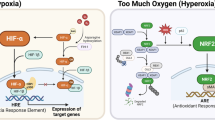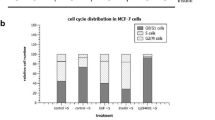Abstract
Hypoxia is a characteristic pathophysiological property of locally advanced solid tumors and a relevant factor of the tumor (patho-)physiome since it can promote tumor progression and resistance to therapy. Tumors alter their metabolic pathways to survive in nutrient and oxygen poor microenvironments by a process known as the “Warburg Effect.” The current studies identify a novel tumor suppressor gene, termed oxidored nitro domain-containing protein 1 (NOR1) which alters hypoxia cellular response in nasopharyngeal carcinoma. NOR1 expression causes apoptosis of tumor cells in hypoxia by altering the expression of PDK1 expression and mitochondrial Bax-Bcl2 balance thus suppress tumor cell adaptation to hypoxia. Although the importance of hypoxia cellular response is well documented in tumor progression, this is the first demonstration of a human tumor suppressor which functions by regulating mitochondrial apoptotic pathways to suppress tumor survival in oxygen poor microenvironments.






Similar content being viewed by others
References
Vaupel P, Mayer A (2007) Hypoxia in cancer: significance and impact on clinical outcome. Cancer Metastasis Rev 26(2):225–239. doi:10.1007/s10555-007-9055-1
Gatenby RA, Smallbone K, Maini PK, Rose F, Averill J, Nagle RB, Worrall L, Gillies RJ (2007) Cellular adaptations to hypoxia and acidosis during somatic evolution of breast cancer. Br J Cancer 97(5):646–653. doi:10.1038/sj.bjc.6603922
Brahimi-Horn MC, Chiche J, Pouyssegur J (2007) Hypoxia and cancer. J Mol Med (Berl) 85(12):1301–1307. doi:10.1007/s00109-007-0281-3
Jelinek J, Gharibyan V, Estecio MR, Kondo K, He R, Chung W, Lu Y, Zhang N, Liang S, Kantarjian HM, Cortes JE, Issa JP (2011) Aberrant DNA methylation is associated with disease progression, resistance to imatinib and shortened survival in chronic myelogenous leukemia. PLoS One 6(7):e22110. doi:10.1371/journal.pone.0022110
Kroeger H, Jelinek J, Estecio MR, He R, Kondo K, Chung W, Zhang L, Shen L, Kantarjian HM, Bueso-Ramos CE, Issa JP (2008) Aberrant CpG island methylation in acute myeloid leukemia is accentuated at relapse. Blood 112(4):1366–1373. doi:10.1182/blood-2007-11-126227
Shen L, Kantarjian H, Guo Y, Lin E, Shan J, Huang X, Berry D, Ahmed S, Zhu W, Pierce S, Kondo Y, Oki Y, Jelinek J, Saba H, Estey E, Issa JP (2010) DNA methylation predicts survival and response to therapy in patients with myelodysplastic syndromes. J Clin Oncol 28(4):605–613. doi:10.1200/JCO.2009.23.4781
Li W, Li X, Wang W, Tan Y, Yi M, Yang J, McCarthy JB, Xiong W, Wu M, Ma J, Su B, Zhang Z, Liao Q, Xiang B, Li G (2011) NOR1 is an HSF1- and NRF1-regulated putative tumor suppressor inactivated by promoter hypermethylation in nasopharyngeal carcinoma. Carcinogenesis 32(9):1305–1314. doi:10.1093/carcin/bgr174
Nie X, Zhang B, Li X, Xiang J, Xiao B, Ma J, Zhou M, Zhu S, Lu H, Gui R, Shen S, Li G (2003) Cloning, expression, and mutation analysis of NOR1, a novel human gene down-regulated in HNE1 nasopharyngeal carcinoma cell line. J Cancer Res Clin Oncol 129(7):410–414. doi:10.1007/s00432-003-0451-9
Xiang B, Wang W, Li W, Li X, Li G (2012) Differential expression of oxidored nitro domain containing protein 1 (NOR1), in mouse tissues and in normal and cancerous human tissues. Gene 493(1):18–26. doi:10.1016/j.gene.2011.11.039
Xiang B, Yi M, Wang L, Liu W, Zhang W, Ouyang J, Peng Y, Li W, Yin D, Zhou M, Liu H, Wu M, Wang R, Li X, Li G (2009) Preparation of polyclonal antibody specific for NOR1 and detection of its expression pattern in human tissues and nasopharyngeal carcinoma. Acta Biochim Biophys Sin (Shanghai) 41(9):754–762
Li W, Li X, Wang W, Yi M, Zhou Y, Zheng P, Xiong W, Yang J, Peng S, McCarthy JB, Xiang B, Li G (2013) Tumor suppressor gene oxidored-nitro domain-containing protein 1 regulates nasopharyngeal cancer cell autophagy, metabolism, and apoptosis in vitro. Int J Biochem Cell Biol 45(9):2016–2026. doi:10.1016/j.biocel.2013.06.020
Ouyang J, Wu M, Huang C, Cao L, Li G (2013) Overexpression of oxidored-nitro domain containing protein 1 inhibits human nasopharyngeal carcinoma and cervical cancer cell proliferation and induces apoptosis: involvement of mitochondrial apoptotic pathways. Oncol Rep 29(1):79–86. doi:10.3892/or.2012.2101
Zeng ZY, Zhou YH, Zhang WL, Xiong W, Fan SQ, Li XL, Luo XM, Wu MH, Yang YX, Huang C, Cao L, Tang K, Qian J, Shen SR, Li GY (2007) Gene expression profiling of nasopharyngeal carcinoma reveals the abnormally regulated Wnt signaling pathway. Hum Pathol 38(1):120–133. doi:10.1016/j.humpath.2006.06.023
Yang J, Liu X, Bhalla K, Kim CN, Ibrado AM, Cai J, Peng TI, Jones DP, Wang X (1997) Prevention of apoptosis by Bcl-2: release of cytochrome c from mitochondria blocked. Science 275(5303):1129–1132
Hockel M, Vaupel P (2001) Tumor hypoxia: definitions and current clinical, biologic, and molecular aspects. J Natl Cancer Inst 93(4):266–276
Wang GL, Semenza GL (1993) Characterization of hypoxia-inducible factor 1 and regulation of DNA binding activity by hypoxia. J Biol Chem 268(29):21513–21518
Elson A, Levanon D, Weiss Y, Groner Y (1994) Overexpression of liver-type phosphofructokinase (PFKL) in transgenic-PFKL mice: implication for gene dosage in trisomy 21. Biochem J 299(Pt 2):409–415
Chow LS, Lo KW, Kwong J, To KF, Tsang KS, Lam CW, Dammann R, Huang DP (2004) RASSF1A is a target tumor suppressor from 3p21.3 in nasopharyngeal carcinoma. Int J Cancer 109(6):839–847. doi:10.1002/ijc.20079
Zhou Y, Zeng Z, Zhang W, Xiong W, Wu M, Tan Y, Yi W, Xiao L, Li X, Huang C, Cao L, Tang K, Shen S, Li G (2008) Lactotransferrin: a candidate tumor suppressor-deficient expression in human nasopharyngeal carcinoma and inhibition of NPC cell proliferation by modulating the mitogen-activated protein kinase pathway. Int J Cancer 123(9):2065–2072. doi:10.1002/ijc.23727
Kim M, Park SY, Pai HS, Kim TH, Billiar TR, Seol DW (2004) Hypoxia inhibits tumor necrosis factor-related apoptosis-inducing ligand-induced apoptosis by blocking Bax translocation. Cancer Res 64(12):4078–4081. doi:10.1158/0008-5472.CAN-04-0284
Kim JW, Tchernyshyov I, Semenza GL, Dang CV (2006) HIF-1-mediated expression of pyruvate dehydrogenase kinase: a metabolic switch required for cellular adaptation to hypoxia. Cell Metab 3(3):177–185. doi:10.1016/j.cmet.2006.02.002
Semenza GL (2009) Regulation of cancer cell metabolism by hypoxia-inducible factor 1. Semin Cancer Biol 19(1):12–16. doi:10.1016/j.semcancer.2008.11.009
Wigfield SM, Winter SC, Giatromanolaki A, Taylor J, Koukourakis ML, Harris AL (2008) PDK-1 regulates lactate production in hypoxia and is associated with poor prognosis in head and neck squamous cancer. Br J Cancer 98(12):1975–1984. doi:10.1038/sj.bjc.6604356
Cuezva JM, Ortega AD, Willers I, Sanchez-Cenizo L, Aldea M, Sanchez-Arago M (2009) The tumor suppressor function of mitochondria: translation into the clinics. Biochim Biophys Acta 1792(12):1145–1158. doi:10.1016/j.bbadis.2009.01.006
Santamaria G, Martinez-Diez M, Fabregat I, Cuezva JM (2006) Efficient execution of cell death in non-glycolytic cells requires the generation of ROS controlled by the activity of mitochondrial H+-ATP synthase. Carcinogenesis 27(5):925–935. doi:10.1093/carcin/bgi315
Acknowledgments
This work was supported by grants from the National Natural Science Foundation of China (81000883, 81372304, 81272254, 81171930 and 81102065), the Natural Science Foundation of Hunan Province, China (14JJ3045), the National “111” Project (111-2-12), Specialized Research Fund for the Doctoral Program of Higher Education (20110162120009).
Conflict of interest
None.
Author information
Authors and Affiliations
Corresponding author
Electronic supplementary material
Below is the link to the electronic supplementary material.
11010_2014_2072_MOESM1_ESM.tif
Supplementary Figure 1 PDK1 mRNA level in hypoxia condition. Realtime quantitative RT-PCR assay of PDK1 mRNA level in normoxia and CoCl2 (150 µM) treatment. PDK1 mRNA in IRES vector-transfected 5-8F cells (white) was significantly induced by CoCl2, however, it’s not so obvious in NOR1 re-expressing cells (black). (TIFF 1520 kb)
Rights and permissions
About this article
Cite this article
Xiang, B., Yi, M., Li, W. et al. Expression of oxidored nitro domain-containing protein 1(NOR1) impairs nasopharyngeal carcinoma cells adaptation to hypoxia and inhibits PDK1 expression. Mol Cell Biochem 393, 293–300 (2014). https://doi.org/10.1007/s11010-014-2072-9
Received:
Accepted:
Published:
Issue Date:
DOI: https://doi.org/10.1007/s11010-014-2072-9




